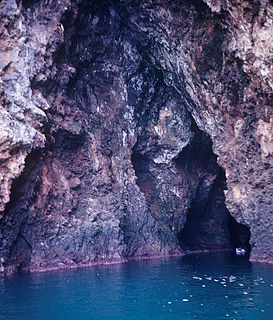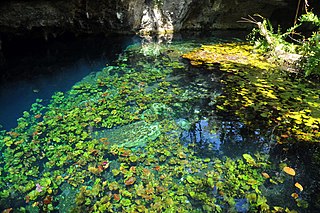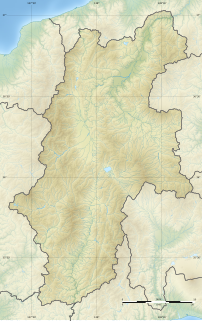External links
| This Novosibirsk Oblast location article is a stub. You can help Wikipedia by expanding it. |
Барсуковская пещера | |
| Location | Russia, Novosibirsk Oblast |
|---|---|
| Type | karst cave |
Barsukovskaya Cave is a karst cave in Maslyaninsky District of Novosibirsk Oblast. Its length is more than 100 meters. The depth of the cave is 19 meters.
Barsukovskaya cave is the habitat of the largest wintering colony of bats in the southeast part of Western Siberia.
| This Novosibirsk Oblast location article is a stub. You can help Wikipedia by expanding it. |

Zhoukoudian Peking Man Site (周口店北京人遗址), also romanized as Choukoutien, is a cave system in suburban Fangshan District, Beijing. It has yielded many archaeological discoveries, including one of the first specimens of Homo erectus, dubbed Peking Man, and a fine assemblage of bones of the gigantic hyena Pachycrocuta brevirostris.

Stravomyti Cave is an ancient Minoan cave on Crete.

Dos Ojos is part of a flooded cave system located north of Tulum, on the Caribbean coast of the Yucatán Peninsula, in the state of Quintana Roo, Mexico. The exploration of Dos Ojos began in 1987 and still continues. The surveyed extent of the cave system is 82 kilometers (51 mi) and there are 28 known sinkhole entrances, which are locally called cenotes. In January 2018, a connection was found between Sistema Dos Ojos and Sistema Sac Actun. The smaller Dos Ojos became a part of Sac Actun, making the Sistema Sac Actun the longest known underwater cave system in the world.

A sea cave, also known as a littoral cave, is a type of cave formed primarily by the wave action of the sea. The primary process involved is erosion. Sea caves are found throughout the world, actively forming along present coastlines and as relict sea caves on former coastlines. Some of the largest wave-cut caves in the world are found on the coast of Norway, but are now 100 feet or more above present sea level. These would still be classified as littoral caves. By contrast, in places like Thailand's Phang Nga Bay, solutionally formed caves in limestone have been flooded by the rising sea and are now subject to littoral erosion, representing a new phase of their enlargement.

Sistema Sac Actun is an underwater cave system situated along the Caribbean coast of the Yucatán Peninsula with passages to the north and west of the village of Tulum. Discovery of a connection to the Sistema Dos Ojos in 2008 made it the longest known underwater cave system.

Rugova Canyon or Rugova Gorge is a river canyon near Peć in Western Kosovo, in the Prokletije mountains, close to the border with Montenegro. With a length of 25 km (16 mi) and a depth up to 1,000 meters, Rugova is considered to be one of Europe's longest and deepest canyons. It was created by water erosion and the retreat of the Peć glacier. The Peć Bistrica river cuts through the canyon.

Aggtelek is a village in the county of Borsod-Abaúj-Zemplén, Hungary. It is known for the vast stalactite caverns of the nearby Baradla-Domica cave system, part of the UNESCO World Heritage Site of Aggtelek and Slovak Karst.
Pendejo Cave is a geological feature and archaeological site located in southern New Mexico about 20 miles east of Orogrande. Archaeologist Richard S. MacNeish claimed that human occupation of the cave pre-dates by tens of thousands of years the Clovis Culture, traditionally believed to be one of the oldest if not the oldest culture in the Americas.

Nahal Amud, also known as the Wadi Amud, is a stream in the Upper Galilee region of Israel that flows into the Sea of Galilee.

Maslyaninsky District is an administrative and municipal district (raion), one of the thirty in Novosibirsk Oblast, Russia. It is located in the east of the oblast. The area of the district is 3,453 square kilometers (1,333 sq mi). Its administrative center is the urban locality of Maslyanino. Population: 24,438 ; 27,196 (2002 Census); 26,421 (1989 Census). The population of Maslyanino accounts for 53.6% of the district's total population.

Gruta de Maquiné (MG-0243), also Lapa Nova de Maquiné, is the oldest and one of the most commercially visited caves in Brazil. It is located about 5 km (3.1 mi) from Cordisburgo and 143 km (88.9 mi) northwest of Belo Horizonte, in the State of Minas Gerais. The cave has seven huge chambers explored, amounting to 650 m (2,130 ft) (linear) and unevenness of the ground of only 18 m (59 ft). Safety measures like lighting, walkways and handrails allow a multitude of visitors to enjoy safely the wonders of the grotto where the whole journey is accompanied by an experienced local guide.
Judge's Cave is a cave in the British Overseas Territory of Gibraltar. Human remains dated to the late prehistoric period have been unearthed in the cave.
Devil's Tower Cave is a cave in the British Overseas Territory of Gibraltar. Archaeologist Dorothy Garrod found a Neanderthal skull in the cave which, together with other evidence found in this cave, shows it was used as a rock shelter by the Neanderthals of Gibraltar.

Satsurblia Cave Natural Monument is a paleoanthropological site located 1.2 km from Kumistavi village, Tsqaltubo Municipality, in the Imereti region of Georgia, 287 meters above sea level. The karst cave was first excavated in 1976 by A. N. Kalandadze.. In the Middle Ages the cave was used as a refuge.

The Cave of Aroeira is an archaeological and paleoanthropological site in the central limestone massif of the Portuguese Estremadura. The cave is located in the village of Almonda, in the civil parish of Zibreira, in the municipality of Torres Novas in the district of Santarém. The cave contained stones from the Paleolithic Acheulean culture, and the skull of Homo heidelbergensis, circa 400,000 years old. The discovery of Aroeira 3 was announced in spring 2017 - the earliest human trace in Portugal.

Ōzakai Cave Dwelling is an archaeological site consisting of a cave dwelling in what is now part of the city of Himi, Toyama Prefecture in the Hokuriku region of Japan. The site was designated a National Historic Site of Japan in 1986.

Muroya Cave is a Jōmon period archaeological site consisting of a cave dwelling in what is now part of the town of Aga, Niigata Prefecture in the Hokuriku region of Japan. The site was designated a National Historic Site of Japan in 1980.

Kosegasawa Cave is a Jōmon period archaeological site consisting of a cave dwelling in what is now part of the town of Aga, Niigata Prefecture in the Hokuriku region of Japan. The site was designated a National Historic Site of Japan in 1982.

Tobayama Cave is an archaeological site consisting of a cave dwelling and cave tomb in use from the late Jōmon, through the Yayoi and early Kofun periods, located in what is now part of the city of Ueda, Nagano in the Chūbu region of Japan. The site was designated a National Historic Site of Japan in 1978.

Berd Rocks is a natural monuments in Iskitimsky District of Novosibirsk Oblast, Russia. Its area is 26.7 hectares.